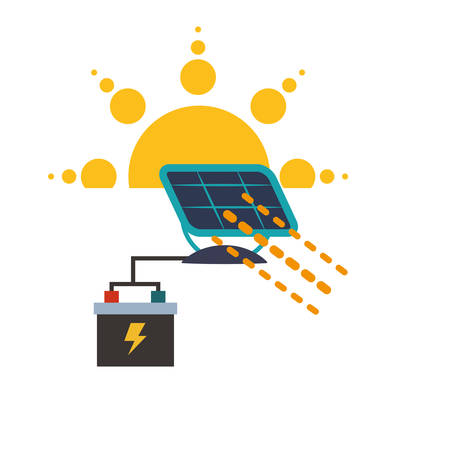Understanding Domestic Solar Panel Systems in the UK
For British homeowners seeking to elevate their property’s energy efficiency, understanding the basics of domestic solar panel systems is the essential first step. Solar panels, or photovoltaic (PV) systems, convert sunlight into electricity, helping reduce reliance on the national grid and lower household energy bills. The UK’s unique climate and architectural heritage influence both the choice and installation of solar panels, making it vital to appreciate how these systems work and what types are best suited for British homes.
How Do Solar Panels Work?
Solar panels consist of interconnected cells made from semiconducting materials, typically silicon. When sunlight hits these cells, it generates a flow of electricity that can be used directly within your home or stored in batteries for later use. Modern PV systems are designed to function efficiently even under typical UK weather conditions, which include frequent cloud cover and variable sunlight.
Common Types of Solar Panels Used in the UK
| Type | Description | Suitability for UK Homes |
|---|---|---|
| Monocrystalline | High efficiency, sleek appearance, more costly | Ideal for homes with limited roof space |
| Polycrystalline | Slightly less efficient, more affordable | Good for larger roof areas with budget considerations |
| Thin-film | Lightweight, flexible design, lowest efficiency | Suitable for unconventional or lightweight roofs |
Key Considerations for British Homes
- Roof orientation and pitch: South-facing roofs receive optimal sunlight exposure in the UK.
- Shading: Trees, chimneys, or nearby buildings can impact performance.
- Aesthetic integration: Conservation areas or listed properties may require special permissions to maintain architectural harmony.
- Energy storage: Pairing solar panels with battery storage maximises efficiency by storing surplus power for use during evenings or cloudy days.
- Government incentives: Homeowners should research current schemes such as the Smart Export Guarantee (SEG) to make informed investment decisions.
The Takeaway
Selecting the right solar panel system involves balancing efficiency, aesthetics, and compliance with local planning regulations. By understanding these fundamentals, UK homeowners can confidently embark on an energy-efficient home transformation that respects both environmental goals and British design sensibilities.
2. The Benefits of Solar Power for British Homeowners
Embracing solar panels is more than just a nod to sustainability—it’s an investment that brings tangible returns to UK households. From impressive financial savings to boosting property value, British homeowners are increasingly discovering the multifaceted advantages of harnessing solar energy.
Financial Savings Tailored to UK Energy Costs
With energy prices in the UK consistently on the rise, solar panels offer a pragmatic solution for reducing monthly bills. Once installed, these systems can drastically cut your reliance on grid electricity. Additionally, government schemes such as the Smart Export Guarantee (SEG) allow homeowners to sell excess power back to the grid, further enhancing savings. Here’s a quick comparison:
| Without Solar Panels | With Solar Panels | |
|---|---|---|
| Average Annual Electricity Bill* | £1,200 | £600–£700 |
| Potential Earnings via SEG | £0 | Up to £150/year |
| Total Estimated Annual Benefit | – | £650–£850 |
*Figures based on typical 3-bedroom UK home as of 2024.
Environmental Advantages: A Greener Britain
The shift towards renewable energy is crucial in meeting the UK’s ambitious carbon reduction targets. By installing solar panels, homeowners directly contribute to lowering their household’s carbon footprint. On average, a typical residential solar array can save over one tonne of CO2 emissions annually—equivalent to planting approximately 30 trees each year.
Boosting Home Value and Market Appeal
Sustainable features are rapidly becoming must-haves for discerning British buyers. Properties equipped with solar panels often enjoy increased market value and enhanced kerb appeal. Recent studies suggest that homes with solar installations may command premiums of up to 4% compared to non-solar counterparts—a smart move if you plan to sell or remortgage in the future.
The British Perspective: Localised Benefits Matter Most
The benefits of solar power aren’t just global—they’re distinctly local. With Britain’s unique climate and support schemes, homeowners here can enjoy dependable performance from modern photovoltaic technology, even under cloudy skies. In summary, investing in solar isn’t simply an environmental gesture; it’s a forward-thinking choice that transforms your home into a model of efficiency and style.

3. Energy Efficiency and Reducing Your Carbon Footprint
When it comes to transforming your home into a beacon of energy efficiency, solar panels are an undeniably impactful solution—especially within the context of the UK’s commitment to reaching net zero emissions. By harnessing the sun’s natural energy, you can drastically reduce your reliance on traditional energy sources, which are often linked to higher carbon emissions and fluctuating costs. This not only aligns with national sustainability goals but also empowers you as a homeowner to make a tangible difference for both your household and the environment.
The Impact of Solar Panels on Home Energy Performance
Solar panels work by converting sunlight into electricity that powers your home’s appliances, lighting, and heating systems. This direct use of renewable energy means you’ll draw less from the National Grid, thereby reducing demand on fossil fuels. Over time, this shift can significantly boost your property’s EPC (Energy Performance Certificate) rating—a crucial consideration for British homeowners looking to improve resale value or meet modern building standards.
Comparing Traditional vs Solar-Powered Homes in the UK
| Feature | Traditional Home | Solar-Powered Home |
|---|---|---|
| Primary Energy Source | Grid electricity (mix of fossil fuels & renewables) | On-site solar generation |
| Annual Carbon Emissions* | ~4,000 kg CO2 | <2,000 kg CO2 |
| EPC Rating Potential | D–C (average UK home) | B–A (with effective solar integration) |
*Figures are approximate and depend on property size and energy usage patterns.
Contributing to a Greener Britain
The broader benefit of adopting solar technology is the collective reduction in national carbon output. As more British households install solar panels, communities move closer to meeting ambitious climate targets set forth by the government. Not only do you gain independence over your energy bills, but you also join a nationwide movement towards clean energy living—helping pave the way for a sustainable future across England, Scotland, Wales, and Northern Ireland.
4. Navigating Government Schemes and Incentives
For UK homeowners considering solar panels, understanding the current government schemes and incentives is crucial to maximising your investment. The landscape of support in the UK is both dynamic and regionally nuanced, offering a range of opportunities to offset installation costs and enhance returns.
Understanding the Support Landscape
The primary incentives available to British homeowners today are designed to encourage the adoption of renewable energy while making it more affordable. These include grants, feed-in tariffs, and export payments—each tailored to different stages of your solar journey.
Main Incentives for Solar Panel Adoption
| Scheme/Grant | Description | Eligibility |
|---|---|---|
| Smart Export Guarantee (SEG) | Pays homeowners for excess electricity exported back to the grid. | All households with MCS-certified solar installations; must use an SEG-licensed energy supplier. |
| ECO4 Scheme | Energy Company Obligation targeting low-income homes for energy efficiency upgrades, including solar panels in some cases. | Low-income or vulnerable households; eligibility depends on benefits received and home energy rating. |
| Zero VAT on Solar Panels | Zero-rated VAT on solar panel installation until March 2027, reducing upfront costs. | All residential properties in Great Britain. |
How to Apply for Grants and Schemes
Applying for these schemes typically requires working with certified installers who can guide you through the eligibility criteria and application process. It’s important to check the latest updates from the UK government or local authorities, as offerings may evolve year by year. Local councils may also provide additional grants or pilot initiatives that are worth investigating.
Making Sense of Feed-In Tariffs
While the traditional Feed-in Tariff (FiT) scheme closed to new applicants in 2019, existing participants continue to benefit from fixed rates. Today, new adopters focus on SEG payments, which vary by supplier—so it’s wise to compare rates before signing up. Remember, the amount you earn will depend on how much surplus energy you generate and export back to the grid.
Cultural Considerations for British Homes
Many UK homeowners value heritage aesthetics and neighbourhood cohesion. Fortunately, modern solar panels are increasingly designed with discreet profiles that blend into rooflines, even within conservation areas—helping you improve efficiency without compromising kerb appeal or local character.
By tapping into these schemes and approaching installation with an eye for both design and regulation, British homeowners can make informed decisions that support their household budgets—and contribute meaningfully to a greener national grid.
5. Design, Aesthetics, and Practical Considerations
Integrating solar panels into British homes presents a unique opportunity to blend sustainability with style. Whether your property is a classic Victorian terrace, a stately Georgian semi, or a sleek new-build, thoughtful design ensures that solar installations enhance rather than detract from architectural charm.
Respecting Traditional Facades
For period homes—think Edwardian bay windows or rustic stone cottages—discreet placement is paramount. Many UK homeowners opt for solar tiles that mimic the look of slate or clay, allowing renewable technology to quietly complement heritage features. When permitted development rules apply, panels can be positioned on less visible roof slopes or garden outbuildings, maintaining the street’s historic character.
Embracing Contemporary Architecture
Modern properties often celebrate minimalism and clean lines, making them ideal canvases for cutting-edge solar solutions. Frameless panels or building-integrated photovoltaics (BIPV) can become part of the architectural language, acting as both energy generators and striking design statements. Orientation and symmetry are key: aligning panels with existing rooflines ensures an intentional and harmonious appearance.
Comparison Table: Solar Panel Integration Options
| Architectural Style | Recommended Solar Solution | Aesthetic Considerations |
|---|---|---|
| Victorian/Edwardian Terraces | Solar Tiles or Discreet Rear Roof Panels | Maintain original roofline; minimise visibility from street |
| Georgian Townhouses | BIPV Slates or Integrated Ridge Panels | Respect symmetry and period features; consult conservation guidelines |
| Countryside Cottages | Pitched Roof Panels in Earthy Tones | Select finishes matching traditional materials; position on outbuildings if possible |
| Modern Builds | Frameless High-Efficiency Panels or BIPV Facades | Emphasise clean lines and integration with overall design scheme |
Navigating Planning Permission and Neighbourhood Harmony
In the UK, planning regulations vary by region and property type—especially for listed buildings or those in conservation areas. Early consultation with local authorities ensures your solar project respects both legal requirements and community aesthetics. Open dialogue with neighbours can also smooth the process, fostering goodwill and shared appreciation for greener living.
Ultimately, with careful planning and creative vision, solar panels can seamlessly elevate your home’s energy efficiency while honouring Britain’s rich architectural heritage.
6. Ongoing Maintenance and Maximising Solar Panel Efficiency
Investing in solar panels is only the first step towards a more energy-efficient British home. To truly reap the long-term benefits, ongoing maintenance is essential—especially considering the UK’s distinct climate, marked by frequent rainfall, occasional snowfall, and variable sunlight hours. Here are expert tips for ensuring your solar panels consistently operate at their peak, keeping your home stylishly sustainable and cost-effective.
Understanding the UK Climate’s Impact on Solar Panels
The UK’s weather is famously unpredictable. While this may seem challenging for solar technology, modern panels are designed to function efficiently even in diffuse light conditions typical of British skies. However, to maintain optimal output year-round, regular care tailored to local weather patterns is crucial.
Top Maintenance Tips for UK Homeowners
| Task | Frequency | UK-Specific Advice |
|---|---|---|
| Visual Inspection | Every 3-6 months | Check after storms or heavy rainfall for debris or moss build-up typical in damp climates. |
| Panel Cleaning | Twice a year (Spring & Autumn) | Rain helps but does not remove bird droppings or urban pollution; use soft water and gentle soap. |
| Professional Servicing | Annually | Have a certified UK installer check electrical connections and inverter health. |
Maximising Performance Through Smart Design Choices
- Position panels at an optimal angle (typically 30–40° in the UK) to capture maximum sunlight across seasons.
- If possible, avoid shading from chimneys or neighbouring properties—consider tree pruning as part of routine garden maintenance.
Monitoring Energy Output
Many modern systems come with apps or online dashboards that allow you to track daily and seasonal performance. By monitoring output trends, you can quickly spot drops in efficiency and address issues before they escalate—a key consideration given the shorter winter daylight hours in Britain.
Long-Term Durability and Warranty Considerations
Select reputable brands offering robust warranties (typically 20–25 years for performance). This ensures peace of mind as you future-proof your home against rising energy costs and evolving environmental standards.
The Aesthetic Advantage
Remember, well-maintained panels not only perform better but also retain their visual appeal, blending seamlessly with classic British architecture or contemporary extensions. Prioritising both function and form contributes to a harmonious, future-forward living space.


